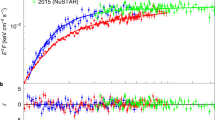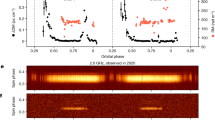Abstract
PSR1744–24A, a binary pulsar in the globular cluster Terzan 5, is eclipsed for up to half of each 109-minute orbit1,2. This is a much longer duration than its 0.09-solar-mass companion star could cause if it were confined within its Roche lobe, and has led to the suggestion that PSR1744–24A is ablating material from its companion, producing an extensive stellar wind that eclipses the radio signal. We have measured the pulsar light curve at a frequency of 1.67 GHz, and find that the eclipse is not total: maximum attenuation in some cases is only about 70 per cent. The pulsar signal is substantially delayed during the eclipse. We model these observations by means of free-free absorption and dispersion in an ionized wind, processes which also explain the frequency dependence of the eclipse duration3. A simplified model predicts a wind density at the Roche surface of ˜6x 107 electrons cm−3 and an electron temperature in the wind of (3.6–15) x 103 K, although some theoretical difficulties remain. Such a wind is unlikely to ablate the companion star entirely in less than a Hubble time, so that in this one case at least, ablation may not ultimately form an isolated millisecond pulsar.
This is a preview of subscription content, access via your institution
Access options
Subscribe to this journal
Receive 51 print issues and online access
$199.00 per year
only $3.90 per issue
Buy this article
- Purchase on Springer Link
- Instant access to full article PDF
Prices may be subject to local taxes which are calculated during checkout
Similar content being viewed by others
References
Lyne, A. G. et al. Nature 347, 650–652 (1990).
Nice, D. J., Thorsett, S. E., Taylor, J. H. Fruchter, A. S. Astrophys. J. 361, L61–L63 (1990).
Rasio, F. A., Shapiro, S. L. Teukolsky, S. A. Astr. Astrophys. 241, L25–L28, (1991).
Ruderman, M., Shaham, J. Tavani, M. Astrophys. J. 336, 507–518 (1989).
Ruderman, M., Shaham, J., Tavani, M. Eichler, D. Astrophys. J. 343, 292–312 (1989).
Fruchter, A. S. et al. Astrophys. J. 351, 642–650 (1990).
Michel, F. C. Nature 337, 236–238 (1989).
Eichler, D. Astrophys. J. 370, L27–L30 (1991).
Rasio, F. A., Shapiro, S. L. Teukolsky, S. A. Astrophys. J. 342, 934–939 (1989).
Wasserman, I. Cordes, J. M. Astrophys. J. 333, L91–L94 (1988).
Rybicki, G. B. & Lightman, A. P. Radiative Processes in Astrophysics (Wiley, New York, 1979).
Author information
Authors and Affiliations
Rights and permissions
About this article
Cite this article
Thorsett, S., Nice, D. Eclipses of the ablating binary pulsar PSR1744–24A. Nature 353, 731–733 (1991). https://doi.org/10.1038/353731a0
Received:
Accepted:
Issue Date:
DOI: https://doi.org/10.1038/353731a0
This article is cited by
-
X-rays from the eclipsing pulsar 1957 +20
Nature (1992)
Comments
By submitting a comment you agree to abide by our Terms and Community Guidelines. If you find something abusive or that does not comply with our terms or guidelines please flag it as inappropriate.



